ECU TOYOTA AYGO 2021 Manual PDF
[x] Cancel search | Manufacturer: TOYOTA, Model Year: 2021, Model line: AYGO, Model: TOYOTA AYGO 2021Pages: 546, PDF Size: 81 MB
Page 448 of 546
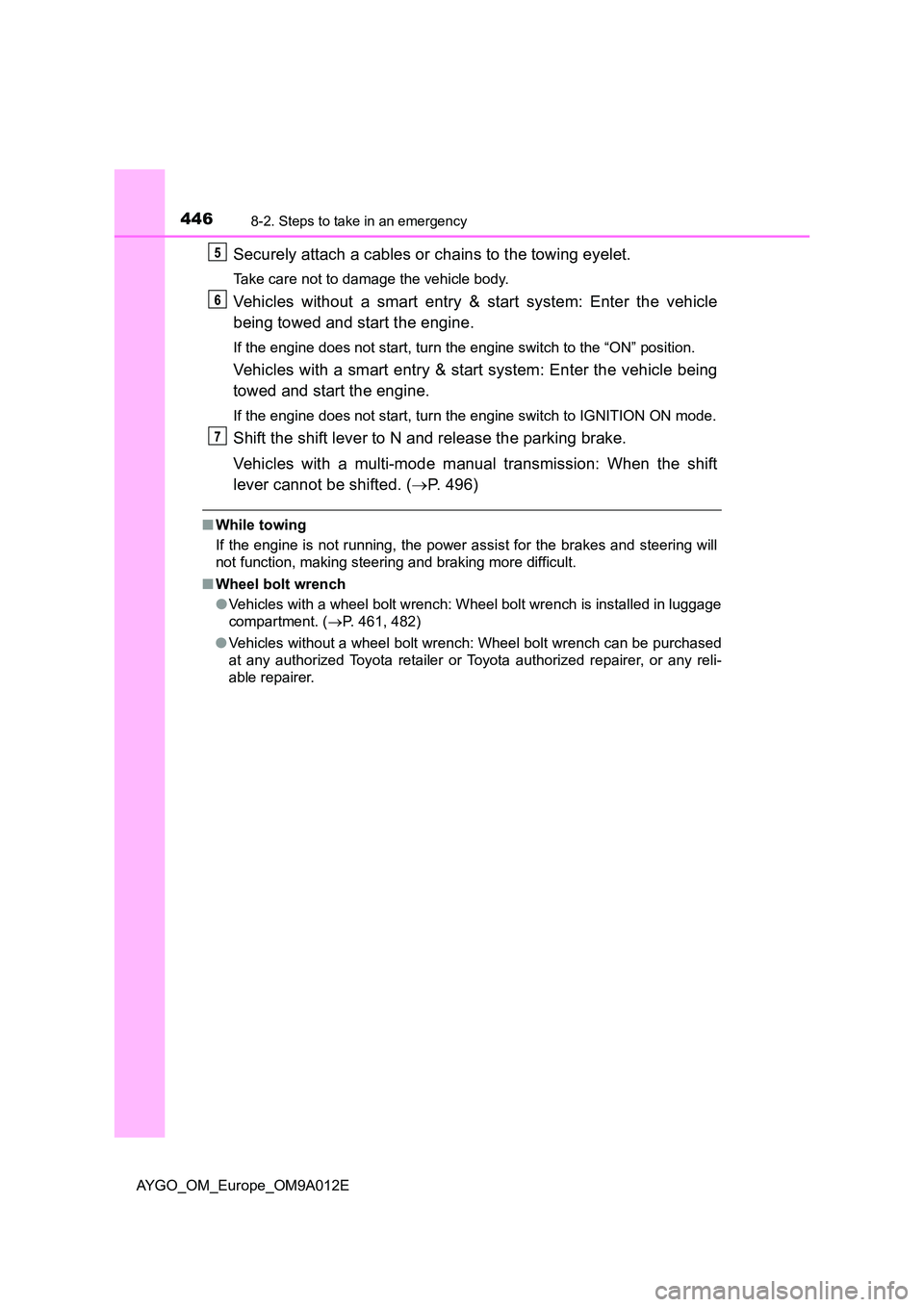
4468-2. Steps to take in an emergency
AYGO_OM_Europe_OM9A012E
Securely attach a cables or chains to the towing eyelet.
Take care not to damage the vehicle body.
Vehicles without a smart entry & start system: Enter the vehicle
being towed and start the engine.
If the engine does not start, turn the engine switch to the “ON” position.
Vehicles with a smart entry & start system: Enter the vehicle being
towed and start the engine.
If the engine does not start, turn the engine switch to IGNITION ON mode.
Shift the shift lever to N and release the parking brake.
Vehicles with a multi-mode manual transmission: When the shift
lever cannot be shifted. ( P. 496)
■While towing
If the engine is not running, the power assist for the brakes and steering will
not function, making steering and braking more difficult.
■ Wheel bolt wrench
● Vehicles with a wheel bolt wrench: Wheel bolt wrench is installed in luggage
compartment. ( P. 461, 482)
● Vehicles without a wheel bolt wrench: Wheel bolt wrench can be purchased
at any authorized Toyota retailer or Toyota authorized repairer, or any reli-
able repairer.
Page 460 of 546
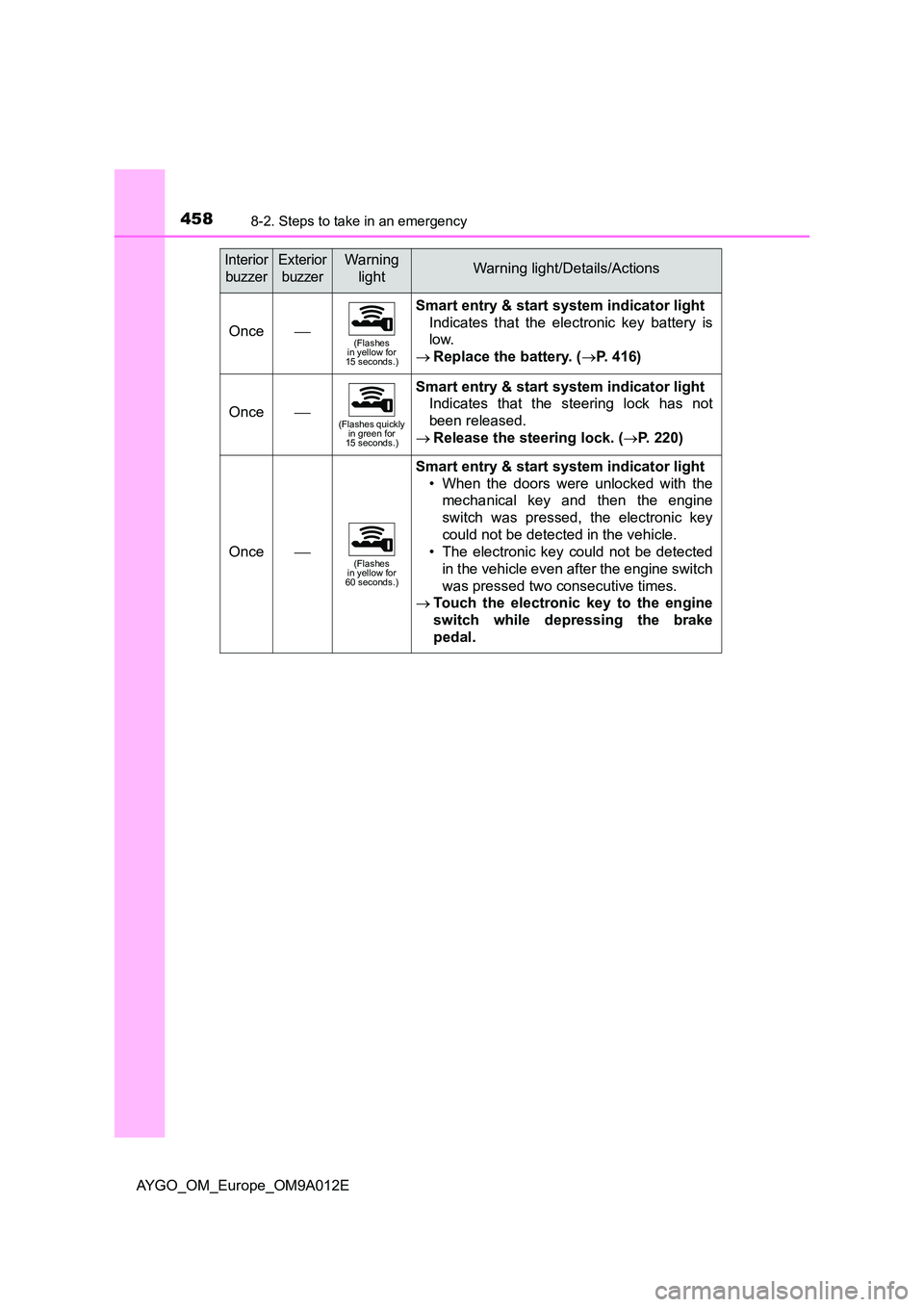
4588-2. Steps to take in an emergency
AYGO_OM_Europe_OM9A012E
Once(Flashes in yellow for 15 seconds.)
Smart entry & start system indicator light
Indicates that the electronic key battery is
low.
Replace the battery. (P. 416)
Once(Flashes quickly in green for 15 seconds.)
Smart entry & start system indicator light
Indicates that the steering lock has not
been released.
Release the steering lock. (P. 220)
Once(Flashes in yellow for 60 seconds.)
Smart entry & start system indicator light
• When the doors were unlocked with the
mechanical key and then the engine
switch was pressed, the electronic key
could not be detected in the vehicle.
• The electronic key could not be detected
in the vehicle even after the engine switch
was pressed two consecutive times.
Touch the electronic key to the engine
switch while depressing the brake
pedal.
Interior
buzzer
Exterior
buzzer
Warning
lightWarning light/Details/Actions
Page 481 of 546
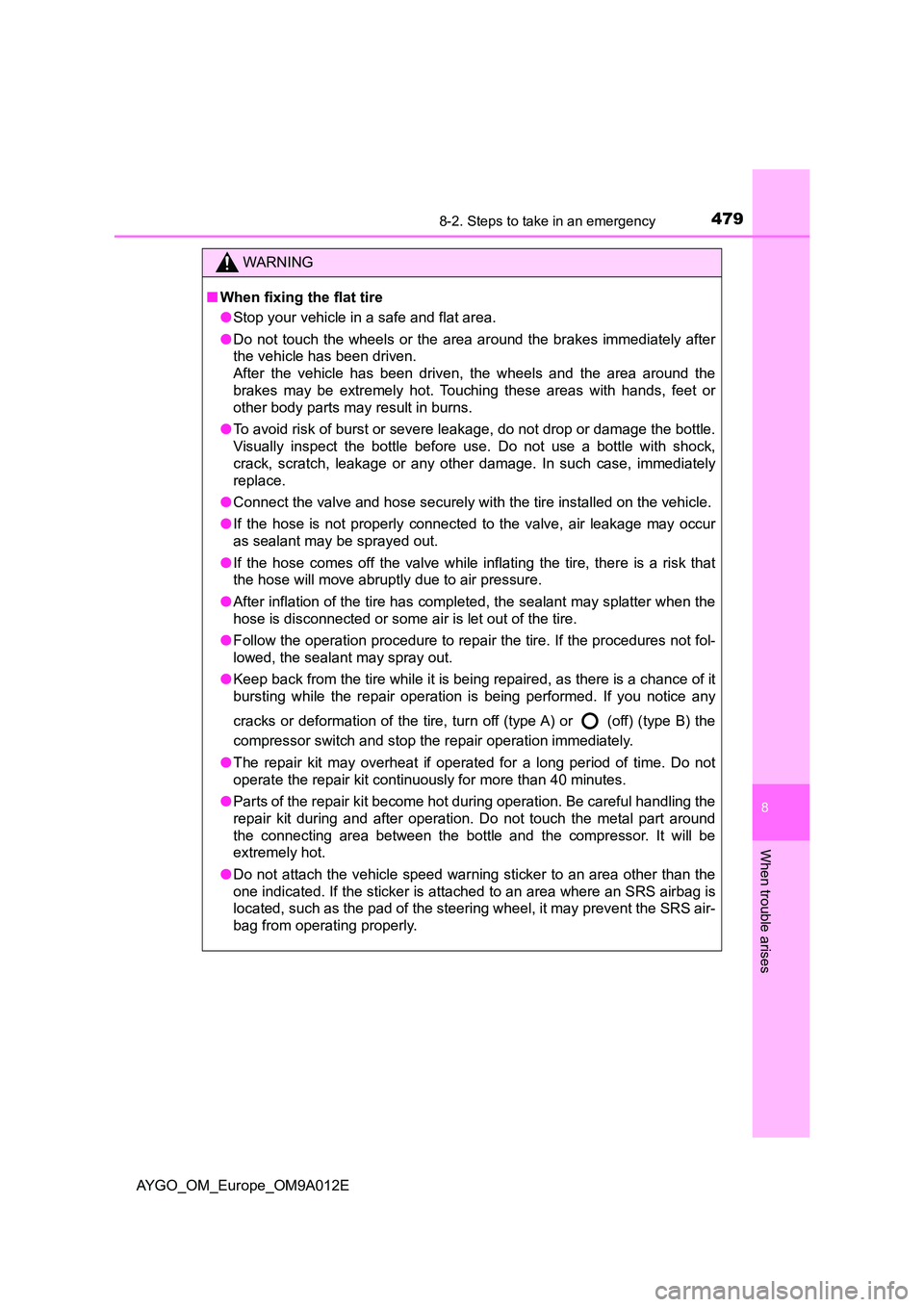
4798-2. Steps to take in an emergency
8
When trouble arises
AYGO_OM_Europe_OM9A012E
WARNING
■When fixing the flat tire
● Stop your vehicle in a safe and flat area.
● Do not touch the wheels or the area around the brakes immediately after
the vehicle has been driven.
After the vehicle has been driven, the wheels and the area around the
brakes may be extremely hot. Touching these areas with hands, feet or
other body parts may result in burns.
● To avoid risk of burst or severe leakage, do not drop or damage the bottle.
Visually inspect the bottle before use. Do not use a bottle with shock,
crack, scratch, leakage or any other damage. In such case, immediately
replace.
● Connect the valve and hose securely with the tire installed on the vehicle.
● If the hose is not properly connected to the valve, air leakage may occur
as sealant may be sprayed out.
● If the hose comes off the valve while inflating the tire, there is a risk that
the hose will move abruptly due to air pressure.
● After inflation of the tire has completed, the sealant may splatter when the
hose is disconnected or some air is let out of the tire.
● Follow the operation procedure to repair the tire. If the procedures not fol-
lowed, the sealant may spray out.
● Keep back from the tire while it is being repaired, as there is a chance of it
bursting while the repair operation is being performed. If you notice any
cracks or deformation of the tire, turn off (type A) or (off) (type B) the
compressor switch and stop the repair operation immediately.
● The repair kit may overheat if operated for a long period of time. Do not
operate the repair kit continuously for more than 40 minutes.
● Parts of the repair kit become hot during operation. Be careful handling the
repair kit during and after operation. Do not touch the metal part around
the connecting area between the bottle and the compressor. It will be
extremely hot.
● Do not attach the vehicle speed warning sticker to an area other than the
one indicated. If the sticker is attached to an area where an SRS airbag is
located, such as the pad of the steering wheel, it may prevent the SRS air-
bag from operating properly.
Page 494 of 546
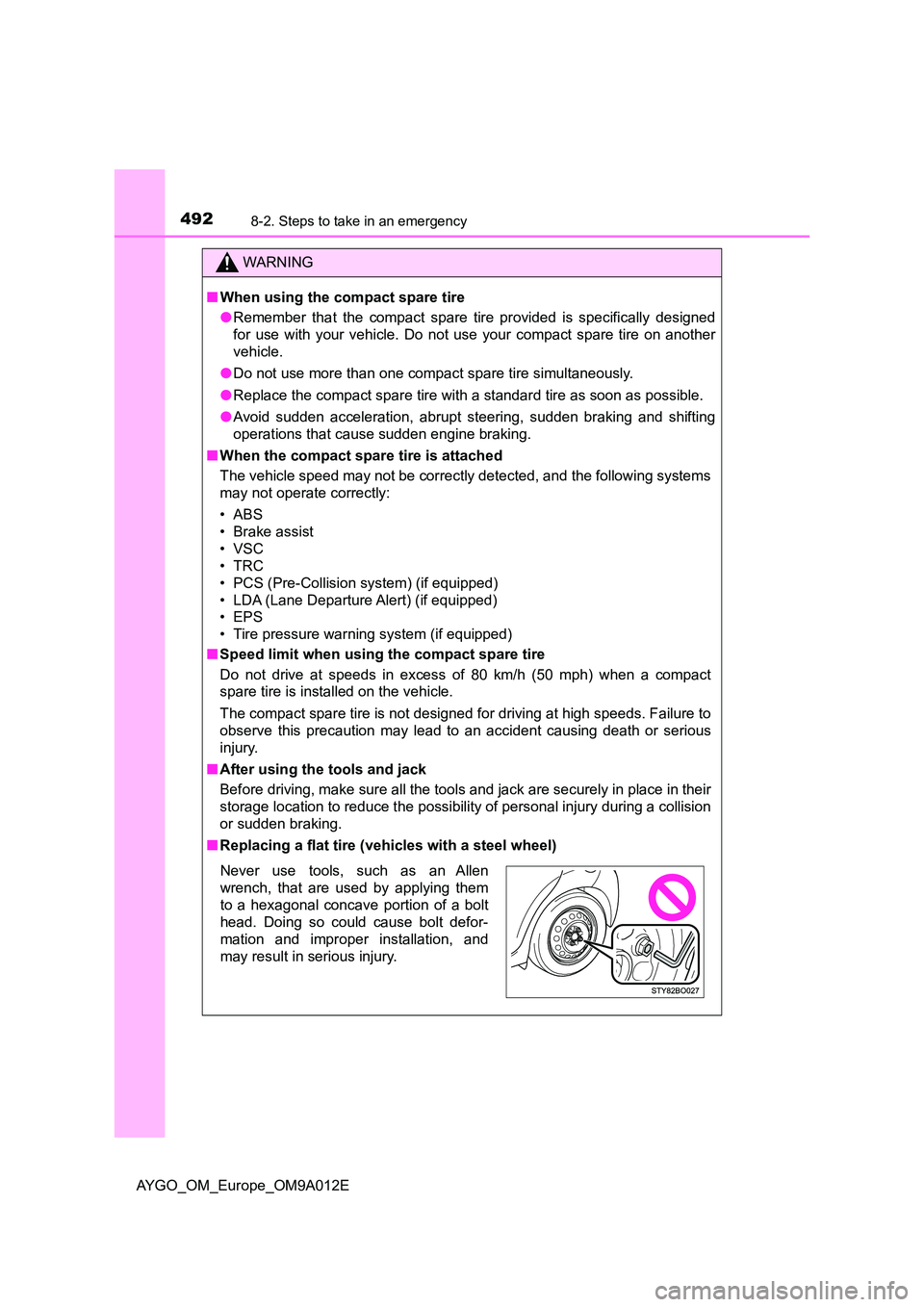
4928-2. Steps to take in an emergency
AYGO_OM_Europe_OM9A012E
WARNING
■When using the compact spare tire
● Remember that the compact spare tire provided is specifically designed
for use with your vehicle. Do not use your compact spare tire on another
vehicle.
● Do not use more than one compact spare tire simultaneously.
● Replace the compact spare tire with a standard tire as soon as possible.
● Avoid sudden acceleration, abrupt steering, sudden braking and shifting
operations that cause sudden engine braking.
■ When the compact spare tire is attached
The vehicle speed may not be correctly detected, and the following systems
may not operate correctly:
• ABS
• Brake assist
• VSC
•TRC
• PCS (Pre-Collision system) (if equipped)
• LDA (Lane Departure Alert) (if equipped)
• EPS
• Tire pressure warning system (if equipped)
■ Speed limit when using the compact spare tire
Do not drive at speeds in excess of 80 km/h (50 mph) when a compact
spare tire is installed on the vehicle.
The compact spare tire is not designed for driving at high speeds. Failure to
observe this precaution may lead to an accident causing death or serious
injury.
■ After using the tools and jack
Before driving, make sure all the tools and jack are securely in place in their
storage location to reduce the possibility of personal injury during a collision
or sudden braking.
■ Replacing a flat tire (vehicles with a steel wheel)
Never use tools, such as an Allen
wrench, that are used by applying them
to a hexagonal concave portion of a bolt
head. Doing so could cause bolt defor-
mation and improper installation, and
may result in serious injury.
Page 504 of 546
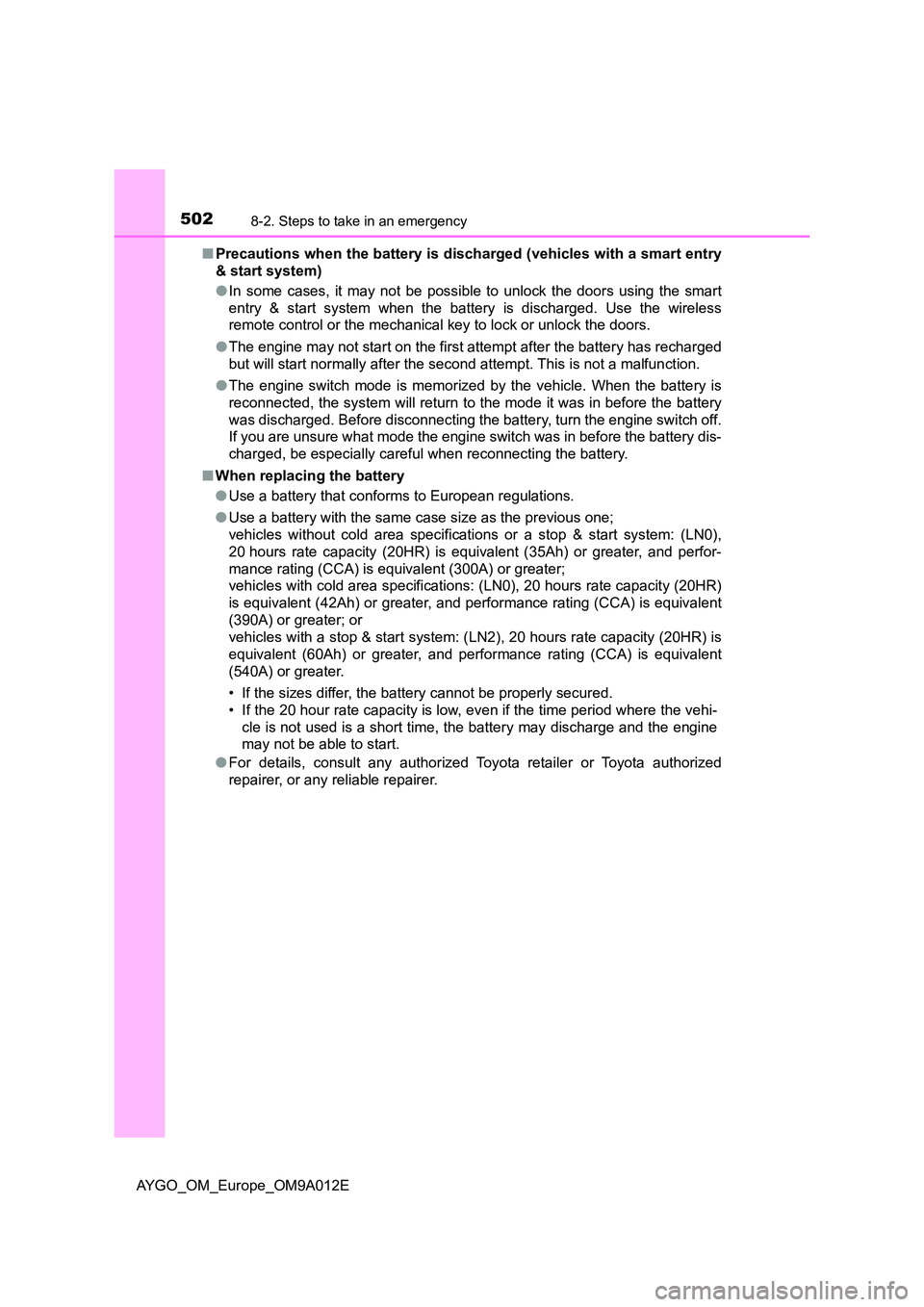
5028-2. Steps to take in an emergency
AYGO_OM_Europe_OM9A012E
■ Precautions when the battery is discharged (vehicles with a smart entry
& start system)
● In some cases, it may not be possible to unlock the doors using the smart
entry & start system when the battery is discharged. Use the wireless
remote control or the mechanical key to lock or unlock the doors.
● The engine may not start on the first attempt after the battery has recharged
but will start normally after the second attempt. This is not a malfunction.
● The engine switch mode is memorized by the vehicle. When the battery is
reconnected, the system will return to the mode it was in before the battery
was discharged. Before disconnecting the battery, turn the engine switch off.
If you are unsure what mode the engine switch was in before the battery dis-
charged, be especially careful when reconnecting the battery.
■ When replacing the battery
● Use a battery that conforms to European regulations.
● Use a battery with the same case size as the previous one;
vehicles without cold area specifications or a stop & start system: (LN0),
20 hours rate capacity (20HR) is equiva lent (35Ah) or greater, and perfor-
mance rating (CCA) is equivalent (300A) or greater;
vehicles with cold area specifications: (LN0), 20 hours rate capacity (20HR)
is equivalent (42Ah) or greater, and performance rating (CCA) is equivalent
(390A) or greater; or
vehicles with a stop & start system: (LN2), 20 hours rate capacity (20HR) is
equivalent (60Ah) or greater, and performance rating (CCA) is equivalent
(540A) or greater.
• If the sizes differ, the battery cannot be properly secured.
• If the 20 hour rate capacity is low, even if the time period where the vehi-
cle is not used is a short time, the battery may discharge and the engine
may not be able to start.
● For details, consult any authorized Toyota retailer or Toyota authorized
repairer, or any reliable repairer.